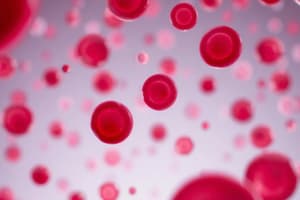Podcast
Questions and Answers
What is the main function of platelets in blood?
What is the main function of platelets in blood?
- Transport nutrients
- Help blood clotting
- Fight infection
- Carry oxygen (correct)
Why can red blood cells carry oxygen efficiently?
Why can red blood cells carry oxygen efficiently?
- They are large in size.
- They are produced in the liver.
- They have a rough surface for better grip. (correct)
- They contain haemoglobin and have a biconcave shape.
What allows microorganisms to grow rapidly in blood?
What allows microorganisms to grow rapidly in blood?
- High levels of oxygen and low temperature.
- Lack of nutrients and moisture.
- Rich in white blood cells.
- Availability of glucose and a warm environment. (correct)
Flashcards are hidden until you start studying
Study Notes
Blood Components
- Blood consists of plasma (a watery liquid) and various cells, including red blood cells, white blood cells, and platelets.
- Plasma carries nutrients, carbon dioxide, urea, and waste products but does not transport oxygen.
- Red blood cells (about 5 billion per cubic cm) are biconcave, enhancing flexibility and surface area for efficient oxygen uptake in lungs.
- White blood cells are crucial for immune response, defending against infectious diseases.
- Platelets facilitate blood clotting by forming a mesh that traps red blood cells at injury sites.
Functions of Blood Components
- Red Blood Cells: Specialized for carrying oxygen to body cells, aided by hemoglobin.
- White Blood Cells: Protect the body by targeting and destroying pathogens.
- Platelets: Essential for initiating the clotting process to prevent excessive bleeding.
- Plasma: Transports digested food, hormones, and serves as a medium for other substances to travel in the blood.
Red Blood Cell Structure
- The biconcave shape allows red blood cells to squeeze through capillaries and increases surface area for gas exchange.
- The top side (outer surface) is adapted for optimal cell interaction with oxygen, while the bottom side (inner surface) holds hemoglobin for oxygen binding.
Oxygen and Nutrient Transport
- Oxygen moves from lungs to body cells during respiration.
- Carbon dioxide exits body cells, entering the blood, and then moves to the lungs for exhalation.
- Nutrients from digested food are taken from the small intestine to body cells via plasma, while urea is carried from the liver to kidneys for excretion.
Blood Testing
- Blood tests can diagnose various diseases and conditions.
- Sickle cell anemia results from faulty hemoglobin, causing red blood cells to become C-shaped and block blood flow, leading to pain and tissue damage.
- Malaria-causing protozoa live in red blood cells, feeding on hemoglobin and obstructing blood flow when they reproduce.
- Sleeping sickness protozoa also circulate in blood, causing multiple symptoms before affecting the brain.
Ideal Conditions for Microbial Growth
- Blood provides an abundant nutrient source, including glucose, fostering rapid microbial growth.
- The warm environment of the human body is conducive to the fast division of microorganisms present in the bloodstream.
Summary Tables
-
Blood Component Functions:
- Red blood cell: Oxygen transport.
- White blood cell: Infection defense.
- Platelet: Clotting facilitation.
- Plasma: Nutrient and waste transport.
-
Substance Transport:
- Oxygen: Lungs to body cells.
- Carbon dioxide: Body cells to lungs.
- Digested food: Small intestine to body cells.
- Urea: Liver to kidneys.
Studying That Suits You
Use AI to generate personalized quizzes and flashcards to suit your learning preferences.




